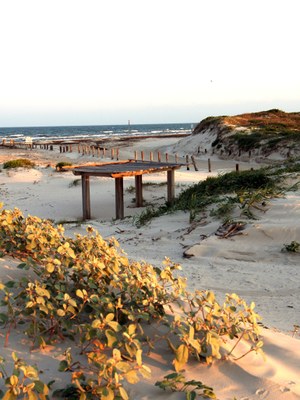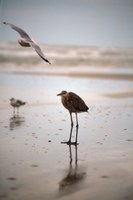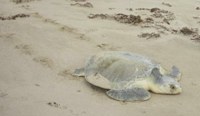Nature
A barrier island is a unique ecosystem, and is home to an interesting variety of plants and animals.
Geology
Mustang Island is 18 miles long and varies from only 3,000 feet wide on the south end to just over two miles wide on the north end. It is part of a chain of barrier islands which run along the Texas Gulf Coast. Barrier islands protect the bays and the mainland from the waves, wind, tides and storms of the Gulf of Mexico.
How were these islands formed? Around 18,000 years ago, as the most recent ice age waned, the sea level was lower than it is now. Rivers carried sand and soil to the gulf, creating sandbars.
Over time, the sea level rose, and the ocean currents carried sand from those sandbars in toward the present-day shore. The sand built up, eventually forming the long, skinny barrier islands about 2,500 years ago. These islands are almost entirely made of sand.
Barrier islands are dynamic landforms. This means that they continue to change, sculpted by climate, wind, waves, tides, ocean currents and storms. Humans have altered the islands, too.
Coastal dunes
The coastal sand dunes are the first line of defense to help the barrier islands protect the bay and mainland. The dunes reduce the might of hurricane-driven waves.
Sand dunes along the gulf can rise 30 feet or more, though the average is 15 to 20 feet. The back side of the dunes is somewhat sheltered from the wind and salt spray. Tenacious vines and deep-rooted coastal grasses can gain footholds there and help stabilize dunes.
These huge dunes are quite delicate. Strong storms can wash the sand away; strong winds can blow the sand away. Walking and driving on dunes can damage them, also. Damage done in one day can take years to heal.
Animals
Rodents such as pocket gophers, spotted ground squirrels, grasshopper mice, rice rats and cotton rats dominate the island community. You might also see mammals like opossums, raccoons, coyotes and white-tailed deer.
An estimated 600 species of saltwater fish inhabit the coastal waters. The bay side of the island acts as a nursery for sea creatures. Shrimp, crabs and fish of all kinds grow in these protected waters before migrating to the open gulf.
Some of the best fishing in Texas is right here on Mustang Island. Anglers can surf fish in the Gulf of Mexico, cast from the Fish Pass jetties, or wade or kayak fish in Corpus Christi Bay.
Birds
The coast and this park are a birding mecca, with over 400 bird species identified here. These include the aplomado falcon and reddish egret as well as many passerines (perching birds), especially during spring and fall migration. Mustang Island is a great place to observe migrating birds that tend to concentrate along the coastline.
Migrant birds are especially numerous and visible when cold fronts pass and bad weather forces birds of all species to stop flying. During such “fall-outs,” birders can see many different species seeking cover on the beach, dunes and grasslands of the island.
Aplomado Falcons
Aplomado falcons disappeared in the wild in Texas more than a half-century ago. A recovery effort for this endangered species began in 1984, led by The Peregrine Fund. In the summers of 2012 and 2013, biologists released 65 captive-bred falcons at Mustang Island State Park. You may be able to spot an aplomado falcon at Mustang Island today.
Sea turtles
The Gulf of Mexico is home to five species of sea turtles. Two of them visit the park.
Juvenile Atlantic green sea turtles can often be seen darting around our jetties, actively swimming and searching for food. These green sea turtles can live to be over 100 years old. Their name comes from the color of their internal fat, which turns green due to their largely plant-based diet.
One of the most endangered sea turtles is the Kemp’s ridley, which only nests on the beaches of Mexico and the Texas coast, including Mustang Island. The Kemp’s ridley is the smallest sea turtle in the world, weighing about 90 pounds. These turtles come ashore to lay their eggs in the sand annually from April through late July. Visitors to the park during nesting season should be on alert for turtles on the beach. Drivers should obey the speed limit to avoid injuring a well camouflaged sea turtle in the sand. Please notify park staff immediately of any sea turtle activity on the beach.
Find more information on the animals of Mustang Island State Park:
- Birds of Mustang Island State Park and Vicinity
- Butterflies and Moths of Nueces County
- Migration and the Migratory Birds of Texas
- Keep Texas Wild: Gulf Coast (TPWD video)
- Find information about specific birds on All About Birds
- Just for kids: Beach Tidings
- Just for kids: Wondrous Wetlands
Plants
 Plants on Mustang Island have an important job: Stabilize the loose sand and reduce the effects of wind and water erosion.
Plants on Mustang Island have an important job: Stabilize the loose sand and reduce the effects of wind and water erosion.
Plants must be tough to survive in this environment. Rainfall averages about 30 inches per year, while water is lost through evaporation at an even higher rate.
Three broad types of habitat occur on the island.
- Beach front and fore dunes: Low-growing forbs (herbs) such as cenicilla, beach morning glory and railroad vine grow on the gulf side of the dunes. These plants help begin the dune building process by trapping sand as it blows across the beach. Sea oats and bitter panicum grow on top of the dunes, while more forbs and grasses grow on the back side.
- Interior barrier grasslands: Some of the same forbs grow on the sand mounds in this area. Grasses like seacoast bluestem, Gulf cordgrass, gulfdune paspalum and many other grasses, sedges and forbs grow here. Freshwater wetlands in this area, which are home to cattails and several other wetland plants, provide drinking water for wildlife.
- Wind tidal flats, sand flats and mud flats: The back side of the island is a salty, marshy area. The evaporation rates are often high and during dry periods you can see beautiful sparkly salt crystals on the surface of the sand flats. Salt-tolerant plants such as saltmarsh cordgrass and black mangroves grow here. Blue-green algae often cover the tidal flats and support many insects and other invertebrates eaten by shore birds. Just offshore, valuable seagrass beds provide habitat for many species of marine life from redfish to blue crabs.
Sargassum: Sargassum, or seaweed, that washes up on shore is crucial to a healthy beach. Sargassum traps sand particles and reduces beach erosion. When it breaks down, it releases nutrients into the sand which nourish the plants that grow in the dunes. Those healthy plants anchor the dunes in place. The plants and sargassum also provide food and shelter for beach animals.
Find more information on the plants of Mustang Island State Park:
- To look up an unknown plant, try Wildflower Center Native Plant Database
- Plant Guidance by Ecoregions: Gulf Coast Prairies and Marshes



